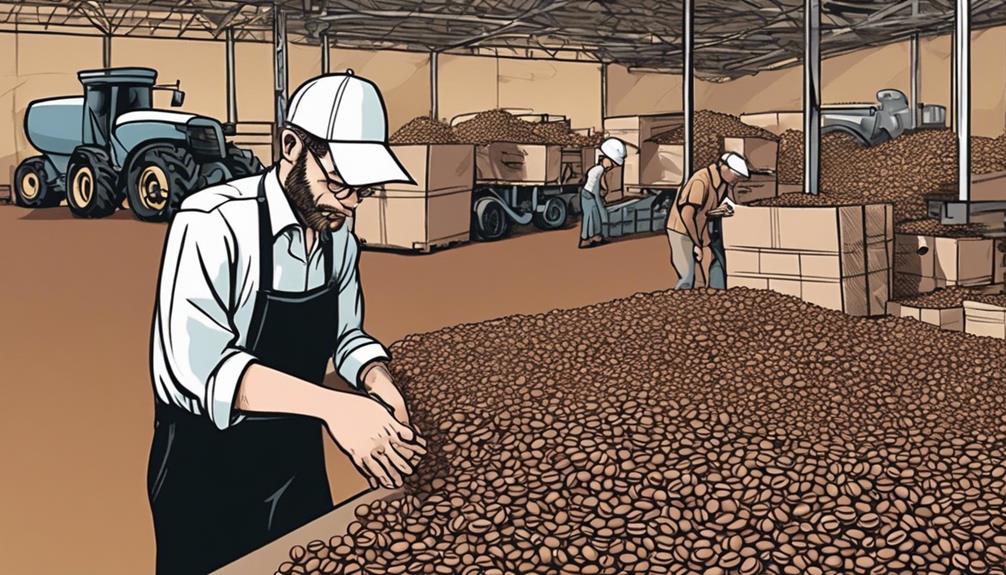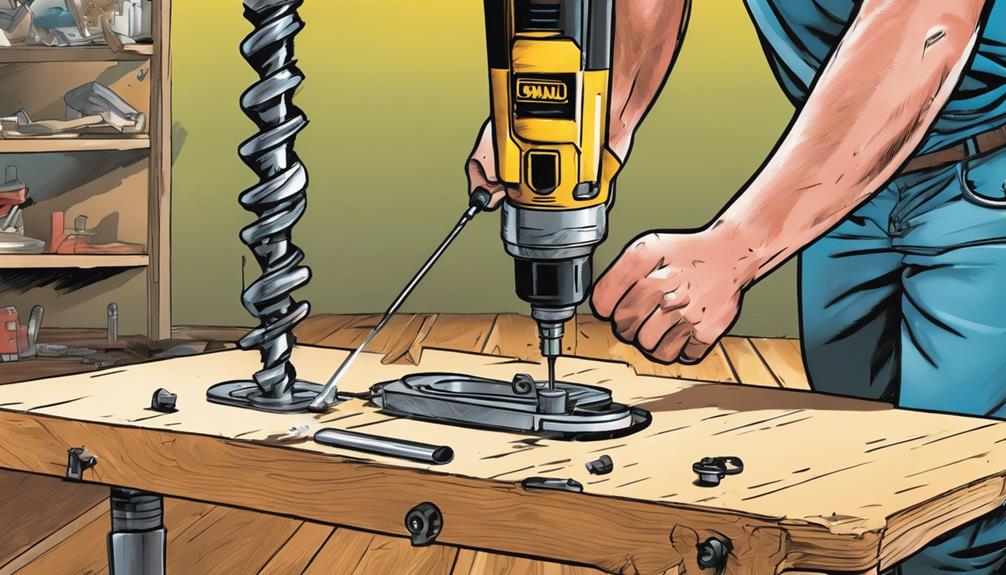To be a successful coffee supplier, master industry knowledge, define your target market, choose quality manufacturers, get proper licensing, and prioritize quality and sustainability. Understanding industry trends and selecting the right beans and roasting techniques are essential. Networking, showcasing on social media, and operating efficiently matter. Key aspects include storage, inventory management, and location evaluation. Emphasize direct relationships with farmers, sustainable practices, and fair compensation. Quality beans and supplier dependability are crucial for customer satisfaction. Your journey to becoming a top coffee supplier begins with these essential steps. Establishing a strong online presence through a user-friendly website and engaging content will also help in reaching a wider audience and building credibility. Additionally, offering educational resources and hosting coffee tasting events can further cultivate a loyal customer base. By prioritizing these elements, you will be well on your way to becoming a coffee connoisseur and a reputable supplier in the industry.
Key Takeaways
- Establish direct relationships with coffee farmers for quality beans.
- Prioritize sustainable practices and ethical sourcing.
- Focus on fair compensation for growers to ensure long-term partnerships.
- Implement rigorous quality control measures to maintain consistency.
- Invest in the supply chain for dependable and exceptional tasting coffee.
Mastering Coffee Industry Knowledge
To excel in the coffee sector as a supplier, mastering essential industry knowledge is pivotal. Understanding the nuances of specialty coffee, high-quality coffee, and the role of coffee suppliers is significant. Having a strong grasp of industry trends, such as the shift towards sustainable and ethically sourced coffee, is also crucial for success. Additionally, learning from professional coffee roaster tips can provide valuable insights into the production and distribution process, ultimately helping suppliers to meet the demands of the market and exceed customer expectations. Mastering these essential aspects will position coffee suppliers to thrive in the competitive industry. Continuous education and staying updated on the latest coffee industry developments, such as new brewing techniques and flavor profiles, is critical for suppliers looking to remain competitive. By incorporating professional coffee roaster tips into their operations, suppliers can improve the quality and consistency of their products, leading to increased customer satisfaction and loyalty. Ultimately, this dedication to excellence will set them apart in the market and contribute to their long-term success.
In a market valued at $225.2 billion globally, with a 2.6% annual growth rate, being well-versed in coffee production hotspots like Brazil, Vietnam, Colombia, and Indonesia is indispensable. These countries collectively produce over 60% of the world's coffee output.
As a coffee supplier, grasping key business aspects such as supply chain management, quality control, marketing strategies, and consumer trends will set you apart in the industry. It's crucial to be familiar with various coffee types like Arabica and Robusta, brewing methods such as espresso and pour-over, and coffee bean processing techniques.
Furthermore, staying informed about industry trends like the surge in specialty coffee, sustainable sourcing practices, and innovative brewing methods will position you for success as a coffee supplier.
Defining Your Target Market
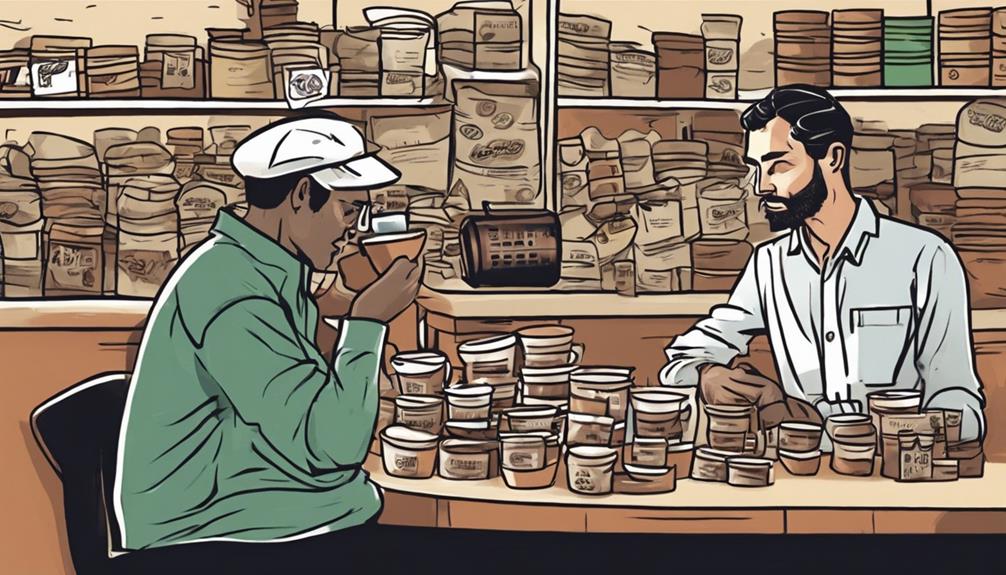
When defining your target market, consider whether you aim to reach retail, wholesale, or commercial customers to align with your business objectives.
Analyze industry trends such as the rise of gourmet coffee or single-serve options like K-Cups to meet evolving consumer demands.
Develop brand differentiation strategies to offer unique products and services that set you apart in a competitive market landscape.
Target Market Selection
Identify the primary customer segment for your coffee supply business by examining their preferences and purchasing behaviors. To define your target market effectively, consider whether you are focusing on retail, wholesale, or commercial clients. Understanding the specific needs and preferences of your target market is essential for tailoring your offerings and marketing strategies. Take into account industry trends like the increased demand for gourmet coffee or single-serve options like K-Cups to align your products with market demands. Analyzing supply and demand dynamics in the coffee industry will help you strategically position your brand and offerings. Additionally, catering to niche consumer groups, such as organic coffee enthusiasts or specialty coffee connoisseurs, can provide opportunities for targeted marketing and product development.
| Target Market | Coffee Sales | Wholesale Coffee |
|---|---|---|
| Retail Customers | Individual buyers | Small businesses |
| Wholesale Buyers | Bulk purchases | Distributors |
| Commercial Clients | Cafes, restaurants | Corporate offices |
Market Trends Analysis
By analyzing market trends in the coffee industry, you can pinpoint consumer preferences and demands to effectively define your target market.
In the evolving landscape of the coffee industry, specialty coffee is gaining significant traction. Consumers are increasingly drawn to unique offerings like single-origin beans and organic blends. Understanding the appeal of these specialty options can help you tailor your products to meet the requirements of this market segment.
Additionally, consider the influence of convenience trends such as coffee pods and ready-to-drink options on your target market.
Sustainability is another key trend shaping consumer choices in the coffee industry. As more people prioritize ethical and eco-friendly practices, exploring sustainable sourcing methods can attract a growing customer base.
Stay updated on emerging trends like cold brew coffee and plant-based milk alternatives to stay ahead of shifting consumer preferences and guarantee your offerings remain relevant in the competitive market.
Brand Differentiation Strategies
Define your target market in the coffee industry by evaluating whether your focus will be on retail, wholesale, or commercial clients. To establish brand differentiation and a unique market position, consider offering products or services that cater to specific consumer preferences or demographics. By analyzing industry trends, such as the increasing demand for K-Cups or gourmet coffee, you can tailor your brand strategy to stand out from competitors. Create a niche for your coffee supply by identifying untapped consumer groups and developing tailored offerings to meet their needs.
| Brand Differentiation Strategies | Unique Products | Market Position |
|---|---|---|
| Offer specialty blends | ✓ | ✓ |
| Provide sustainable packaging | ✓ | |
| Focus on organic certifications | ✓ | ✓ |
| Collaborate with local artisans | ✓ |
Selecting the Right Manufacturers

How can you ensure that you're selecting the most appropriate coffee manufacturers for your business needs?
To guarantee you partner with the right coffee roasters, prioritize quality control and the roasting process.
Compile a list of reputable manufacturers known for their consistent quality.
Research certifications like Fair Trade or Organic to align with your ethical goals.
Opt for manufacturers that offer customizable options to meet specific client preferences.
Evaluate manufacturers based on their roasting techniques, as this significantly impacts the flavor and aroma of the beans.
Look for a supplier with a proven track record of reliability and on-time delivery to maintain a steady supply of high-quality products.
Obtaining Licensing and Networking

To kickstart your journey as a coffee supplier, it's important to understand the licensing requirements in your area and make sure you have the necessary permits.
Networking plays a key role in expanding your reach and building relationships with potential clients in the industry.
Licensing Requirements Overview
When starting your coffee supply business, obtaining a distribution license is essential to legally operate in your area. Some regions may require attending licensing courses to meet specific industry standards and regulations. It's important to establish a company name or form an LLC to comply with licensing requirements.
By adhering to these regulations, you not only guarantee legality but also build trust with your client base.
To expand your reach and credibility in the industry, consider networking strategies. Attend networking events and leverage business associations to connect with potential clients and establish your presence.
Building a client base takes time and effort, but by showcasing your business through social media platforms, you can attract customers and create a strong online presence.
Networking and licensing go hand in hand in the coffee supply business, so investing in both aspects is vital for your success.
Networking Strategies for Success
To boost your coffee supply business and elevate its presence in the industry, adopting effective networking strategies is vital to securing licensing requirements and expanding your client base.
Networking strategies play a pivotal role in establishing connections within the industry and attracting potential clients. Utilize social media platforms to showcase your products and engage with a broader audience.
Join business associations related to the coffee industry to network with like-minded individuals and potential business partners. Attend industry events, trade shows, and seminars to build relationships and gain insights into the market.
By actively networking, you can increase brand awareness, establish credibility, and ultimately grow your client base. Remember, networking isn't just about making contacts; it's about nurturing relationships that can lead to long-term business opportunities.
Put effort into expanding your network and watch your coffee supply business thrive.
Setting Up Operations Efficiently

Consider securing a suitable physical space with ample storage for coffee beans and equipment to streamline your operations efficiently. When setting up your operations, it is crucial to plan for efficient inventory management systems that allow you to track stock levels and monitor product turnover effectively. Additionally, evaluating different warehouse space options, including temperature-controlled environments, can help preserve the quality of your freshly roasted coffee beans. Look for a location that not only meets your current needs but also offers potential for expansion to accommodate future growth in distribution and reach. Furthermore, developing a robust online presence through a website and social media platforms will enhance your brand visibility and attract potential customers.
| Operation Efficiency Tips | Benefits |
|---|---|
| Secure ample storage space | Streamline operations |
| Efficient inventory management | Track stock levels effectively |
| Consider temperature-controlled environments | Preserve coffee bean quality |
| Evaluate location for expansion opportunities | Accommodate future growth |
| Develop strong online presence | Enhance brand visibility |
Choosing the Best Wholesale Supplier
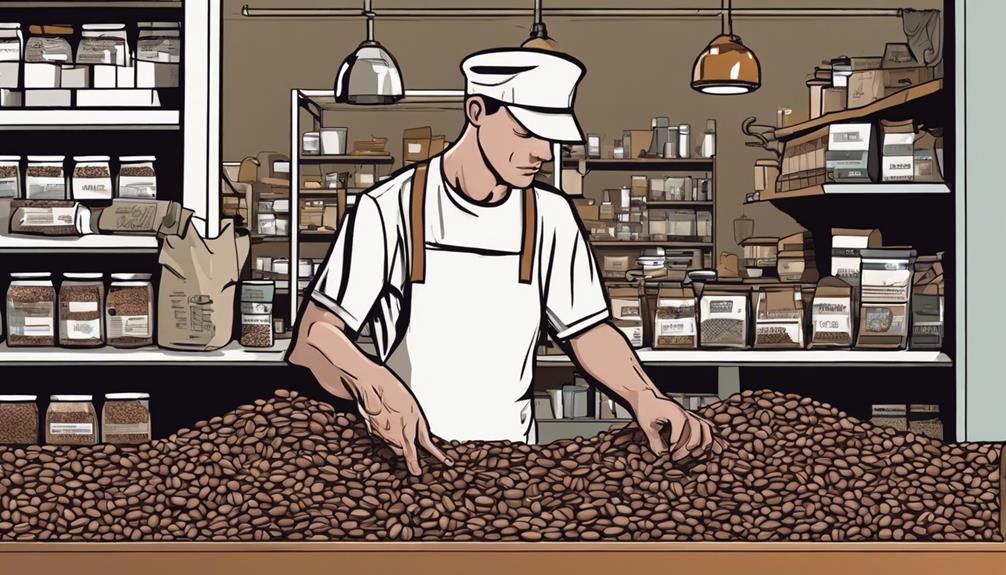
Securing a reliable wholesale supplier for your coffee beans is essential to guarantee the quality and consistency of your product. When selecting the best wholesale supplier, prioritize the quality of the coffee beans they provide. The flavor and aroma of your coffee are directly influenced by the beans' quality.
Additionally, understanding the supplier's roasting techniques is vital. Different techniques can greatly impact the taste profile of the coffee beans you offer.
Consistency and reliability in the supply chain are also crucial. Make sure that the supplier can maintain a steady source of high-quality coffee to meet your business needs.
Ethical and sustainable practices should be a top priority. Consumers value transparency and responsible sourcing, making sustainable practices a competitive advantage.
Look for wholesale suppliers who offer customization options. These can give your coffee distribution business a unique advantage, allowing for special blends or branding opportunities.
Factors for Supplier Selection
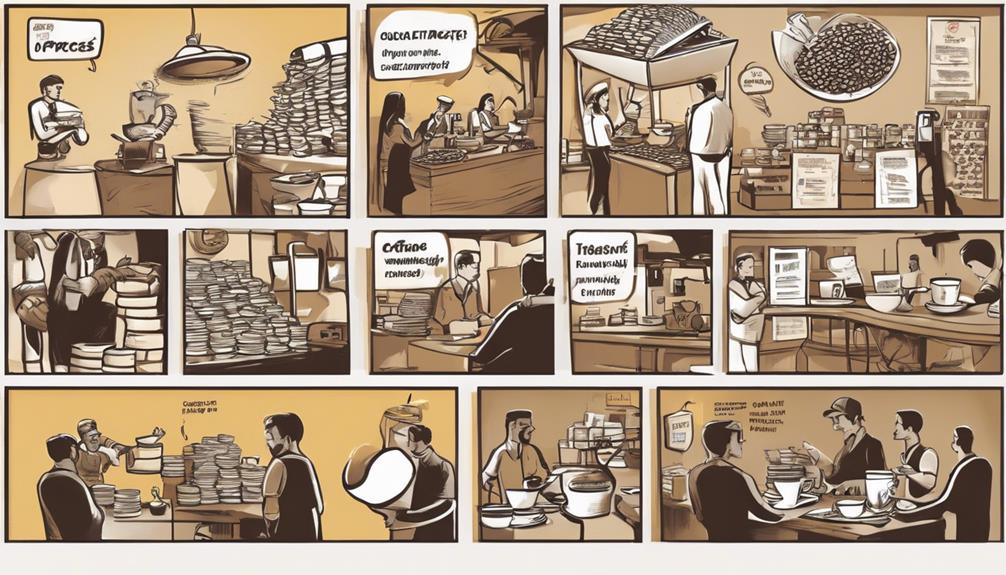
Make sure you assess different significant factors when selecting a coffee supplier for your business. When choosing a coffee supplier, examine their history in the industry to ensure dependability and consistency in the products they deliver. Evaluate their coffee manufacturing methods to guarantee quality beans that will result in exceptional tasting coffee for your customers.
| Factors to Examine | Importance |
|---|---|
| History | High |
| Coffee Manufacturing | High |
| Tasting Coffee | High |
A supplier with a proven history is more likely to meet your expectations and provide a reliable service. Additionally, understanding their coffee manufacturing process will give you insights into the quality of the beans they supply. Ultimately, the goal is to offer your customers the best-tasting coffee possible, and these factors play an essential role in achieving that.
Ensuring Quality and Sustainability
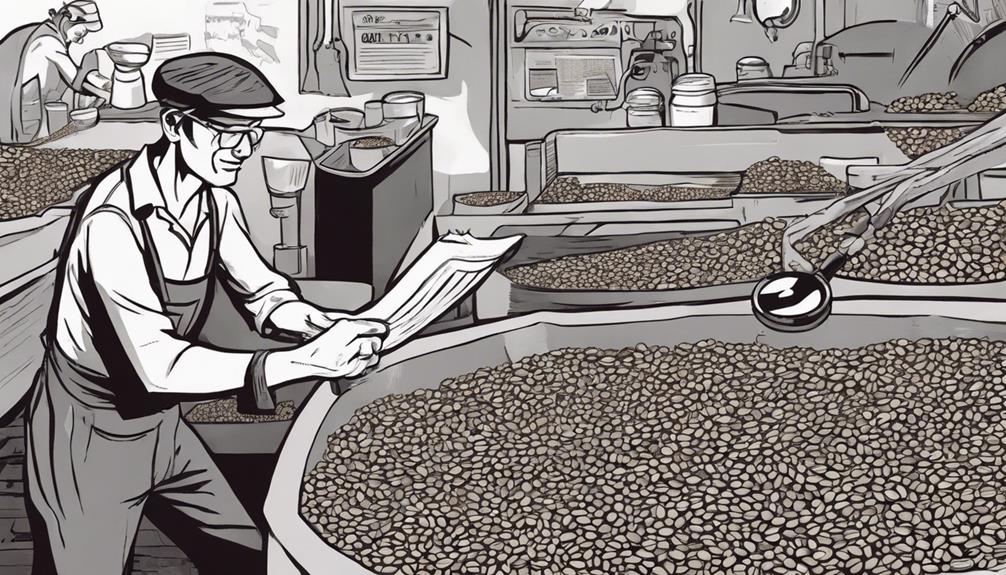
Prioritizing direct relationships with farmers, quality coffee suppliers guarantee high-quality beans for their products.
By ensuring sustainable practices, ethical coffee suppliers not only deliver exceptional coffee but also support fair compensation for growers and environmentally friendly methods.
Sustainable coffee is the cornerstone of ethical sourcing, focusing on the long-term well-being of both the producers and the planet.
Premium coffee suppliers take it a step further by investing in rigorous quality control measures, maintaining consistency in every batch they produce. These suppliers often have in-house coffee labs dedicated to cupping, ensuring that only the finest beans make it to the market.
Frequently Asked Questions
How to Start a Coffee Supplier Business?
To start a coffee supplier business, research market trends, build relationships with growers, establish a distribution network, get licenses, and prioritize sustainability. Implement ethical practices, source high-quality beans, and reach target markets efficiently.
How Do I Find My Coffee Supplier?
To find your coffee supplier, research trade shows, online directories, and seek referrals from industry connections. Contact local roasters and visit coffee farms to establish relationships. Utilize various resources to connect with reliable suppliers and grow your business.
How to Pick a Coffee Supplier?
When choosing a coffee supplier, prioritize quality beans, consistent roasting techniques, reliability, ethical practices, and customization options. Confirm they have direct relationships with farmers, maintain premium flavor profiles, and adhere to fair trade and sustainable sourcing.
How Do I Make My Own Coffee Brand?
To make your own coffee brand, start by crafting a unique identity with striking visuals and messaging. Source high-quality beans, develop signature roasting techniques, and build ethical supply chains. Market boldly and engage customers passionately to thrive in the competitive coffee industry.
Conclusion
Now that you've learned the secrets to being a successful coffee supplier, remember: 'A watched pot never boils.'
Stay patient and persistent as you navigate the world of coffee sourcing and distribution.
By mastering industry knowledge, defining your target market, and selecting the right partners, you're well on your way to a thriving business in the coffee industry.
Keep brewing success one cup at a time!
